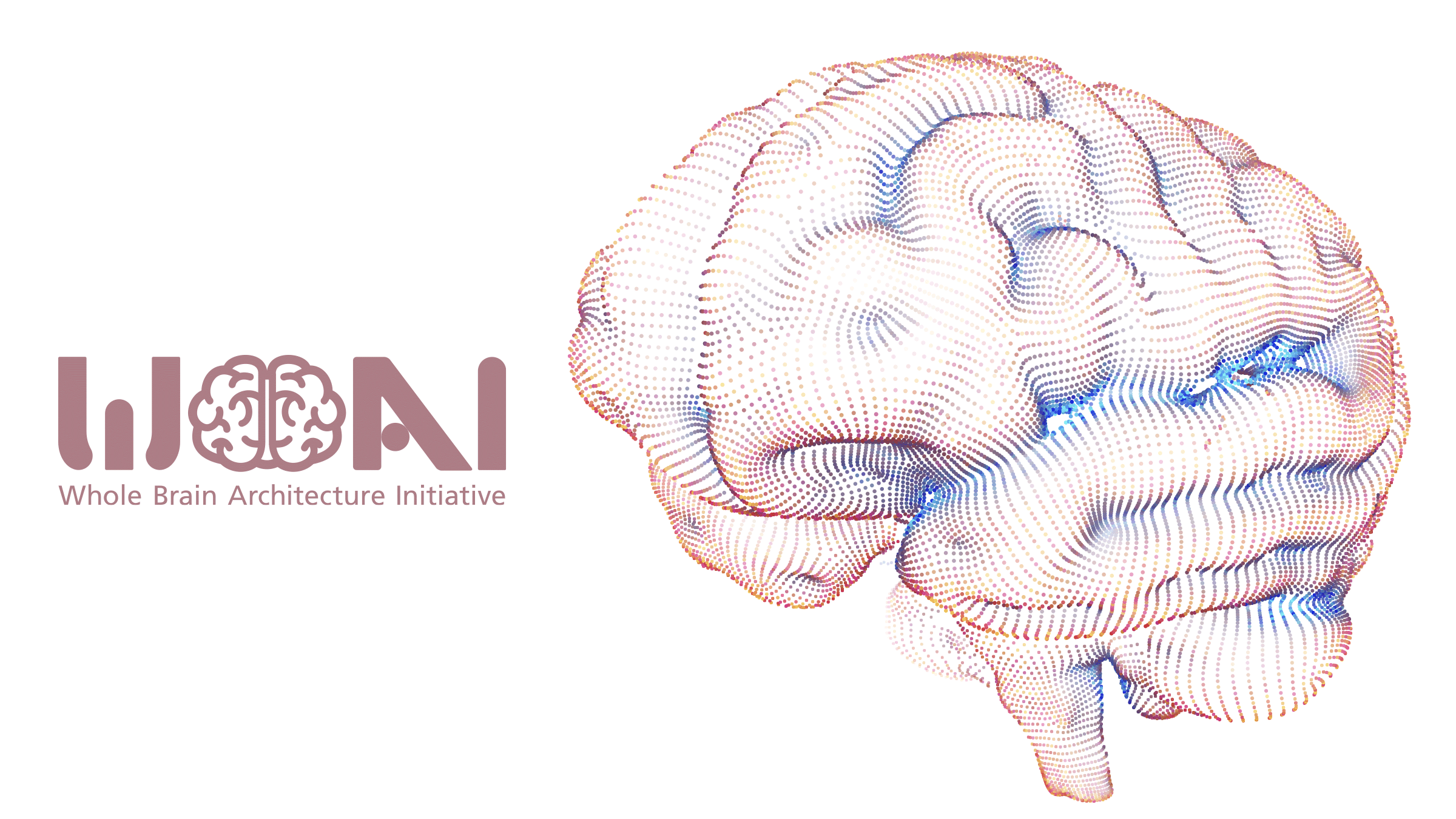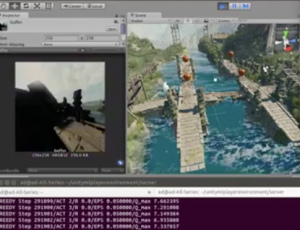Activities in FY2016
Activities in FY2016 (from April 2016 to March 2017 — the second year) include educational and R&D endeavors.
1. Educational Business
The goal of the educational business is to help people who conduct research on the WBA approach on a long-term basis. In the second year, WBAI held the second WBA hackathon and WBA seminars as continued activities.
WBA Seminars
WBA seminars (Japanese site) have been held since before the foundation of WBAI.
In the second year, WBAI held five seminars (in Japanese) with the following themes and speakers:
- 14th Seminar: May 18, 2016, Neocortical Computational Models beyond Deep Learning
with Takuya Matsuda (NPO: Einstein), Manabu Tanifuji (Riken BSI) - 15th Seminar: June 14, 2016, Evolution, Development, and Learning in Intelligence
with Nobuyuki Kawai (Nagoya Univ.), Hiroyuki Okada (Tamagawa Univ.) and Tomoaki Nakamura (UAC) - 16th Seminar: October 12, 2016, How does AI Acquire Meaning?
with Ryutaro Ichise (NII), Shinji Nishimoto (NICT・Osaka Univ.) and Yoshitaka Ushiku (Univ. of Tokyo) - 17th Seminar: February 11, 2017, Aphasia and Developmental Dyslexia
with Shin-ichi Aasakawa (Tokyo Women’s Christian Univ.), Masai Kondo (Kyoto Pref. Univ. of Medicine) and Akira Uno (Tsukuba Univ.) - 18th Seminar: March 13, 2017, Whole Brain Calculation
with Jun Igarashi (Riken) and Takashi Morie (Kyushu Institute of Technology)
The Second Hackathon
WBAI held its second hackathon at the Yokohama campus of Keio University for three days from October 8th with the theme of “Communal making of Cognitive Architecture” aiming for higher autonomy. Eleven teams participated in this event and worked on the theme while staying in lodging facilities on campus. As one of WBAI’s educational activities, this event aimed to improve the knowledge and skill of the participants and provide an opportunity for social networking among students and researchers interested in areas such as neuroscience and machine learning. The event received support from Grant-in-Aid for Scientific Research on Innovative Areas “Comparison and Fusion of Artificial Intelligence and Brain Science” and MEXT Grant: Post K “The Whole Brain Simulation and Brain-like AI”, as well as additional backing from the Dwango AI Lab (Dwango Corporation). Prizes were sponsored by Nextremer Co., Ltd., Furuya Accounting Office, and Brains Consulting, Inc. The products of the hackathon have been published on GitHub.
2. R&D Business
The goal of the R&D business is to support research activities on the WBA approach.
R&D at WBAI
WBAI is actively working to develop research infrastructure such as software and databases to be used in research and make it public. In particular, WBAI is working on a generic software platform for constructing WBA, evaluation methods of AGI, learning environments for WBA, and infrastructure for neuroinformatics.
Generic Software Platform
The generic software platform for constructing WBA supports a mechanism that performs cognitive functions while machine learning modules corresponding to brain parts communicate each other. In particular, platform modules communicate with numeric vector values corresponding to signals transmitted in axons. In collaboration with Riken and Keio University, the effort to create this platform began in 2014. It was named BriCA (Brain-inspired Computing Architecture). Currently a version in C++ to support a/synchronous communication is under development. Together with the BriCA platform, a language that describes its architecture (BriCA Language) has also been designed and implemented.
Learning Environments
Human-like AGI is expected to learn and acquire skills in a world similar to that in which human beings live. In cooperation with the Dwango AI Lab, WBAI is working on robot simulators in the virtual world as learning environment for AGI. The software called Life in Silico (LIS), combining the Unity game engine, Chainer ML modules, and Open AI Gym, was used in the second hackathon.
Fig.: LIS: Unity Game Engine + Chainer
Infrastructure for Neuroinformatics
Knowledge of the architecture of the entire brain is required to create artificial general intelligence on the WBA approach. In particular, the knowledge (information) on the parts of the human/mammalian brain, microstructure of the parts, and interconnection between parts (connectome) are all required. WBAI, together with Dwango AI Lab., has begun systematizing the neuroscientific findings to serve AGI development in forms such as whole brain connectomic architecture and neocortical master algorithm.
3. WBAI Activities and Volunteering
WBAI activities like WBA seminars and hackathons have been conducted with non-paid volunteers, except for two paid part-time workers at the secretariat and hackathon mentors to whom honoraria were paid.
Financial Statements for FY2016
The balance sheet and cash flow for FY2016 are presented below (Table 1 and Table 2).
The operations of WBAI have been financially supported by sponsors including private companies. (As of July 2017, it has nineteen sponsors consisting of enterprises and individuals.) Two of the founding supporters paid fee for five years, as recorded as Advance Received in the balance sheet.
The operating cost includes the subcontractor fees for preparing code for the hackathon and the honoraria for the mentors at the hackathon and speakers at WBA seminars.
The expenses for office personnel have been paid in the forms of subcontracting and outsourcing. The remuneration is paid to an accountant office.
Table 1: Balance Sheet
| Items | Amounts (JPY) | ||||
| Ⅰ
|
Assets | ||||
| 1. | Current Assets | ||||
| Cash and Saving Account | 8,004,226 | ||||
| Total Current Assets | 8,004,226 | ||||
| Total Assets | 8,004,226 | ||||
| Ⅱ
|
Liabilities | ||||
| 1. | Current Liabilities | ||||
| Accounts Payable – Other | 223,938 | ||||
| Advance Received | 7,290,000 | ||||
| Withholding Taxes | 10,210 | ||||
| Total Current Liabilities | 7,524,148 | ||||
| Total Liabilities | 7,524,148 | ||||
| Ⅲ
|
Net Assets | ||||
| Retained Net Assets at the Beginning of Period | 0 | ||||
| Retained Net Assets at the End of Period | 422,810 | ||||
| Total Net Assets | 480,078 | ||||
| Total Liabilities and Net Assets | 8,004,226 | ||||
Table 2: Cash Flow
| Items | Amounts (JPY) | ||||
| Ⅰ
|
Recurring Revenues | ||||
| 1 | Fees | ||||
| Fees from Regular Members |
310,000 |
||||
| Fees from Supporting Members |
6,200,000 |
||||
| Total Fees |
6,510,000 |
||||
| 2 | Other Revenues | ||||
| Interest Income |
114 |
||||
| Total Recurring Revenues |
6,510,114 |
||||
| Ⅱ
|
Ordinary Expenses | ||||
| 1 | Operating Expenses | ||||
| ⑴ | Total Personnel Expenses |
0 |
|||
| ⑵ | Other Expenses | ||||
| Honoraria |
443,749 |
||||
| Subconstractor Expenses |
314,451 |
||||
| Travel Expenses |
158,878 |
||||
| Other |
1,042,702 |
||||
| Total Other Expenses |
1,959,780 |
||||
| Total Operating Expenses |
1,959,780 |
||||
| 2 | Administrative Expenses | ||||
| ⑴ | Total Personnel Expenses |
0 |
|||
| ⑵ | Other Expenses | ||||
| Subconstractor Expenses |
1,743,120 |
||||
| Outsourcing Fees |
1,318,127 |
||||
| Remuneration |
259,200 |
||||
| Rent of Space |
1,051,050 |
||||
| Other |
121,569 |
||||
| Total Other Expenses |
4,493,066 |
||||
| Total Administrative Expenses |
4,493,066 |
||||
| Total Ordinary Expenses |
6,452,846 |
||||
| Net Assets Variation of the Year |
57,268 |
||||
| Net Asset brought forward |
422,810 |
||||
| Net Asset carried forward |
480,078 |
||||




 Japanese
Japanese